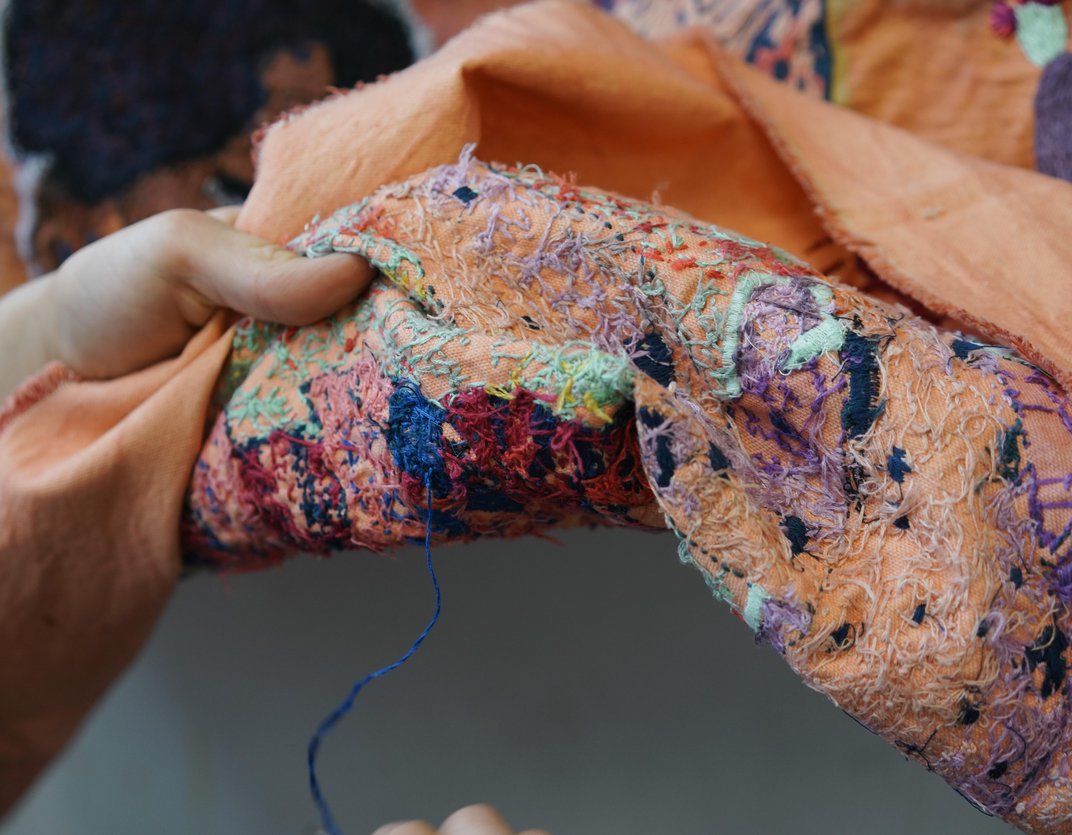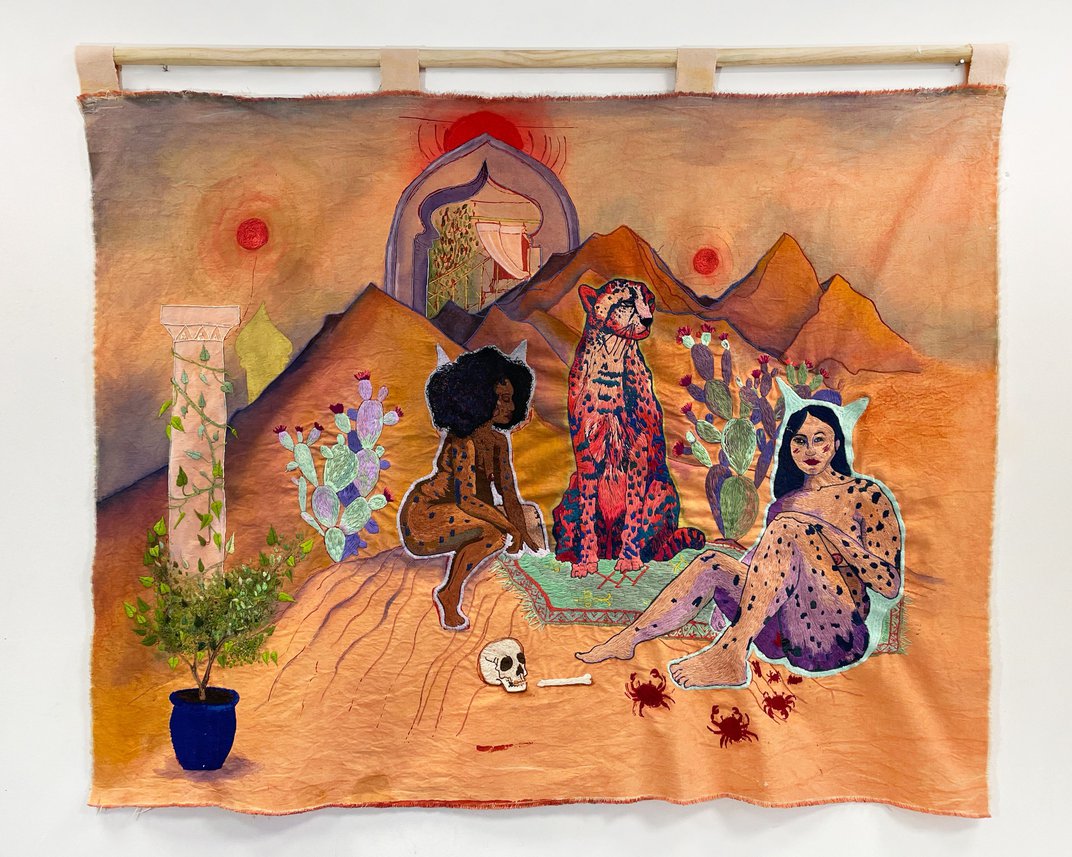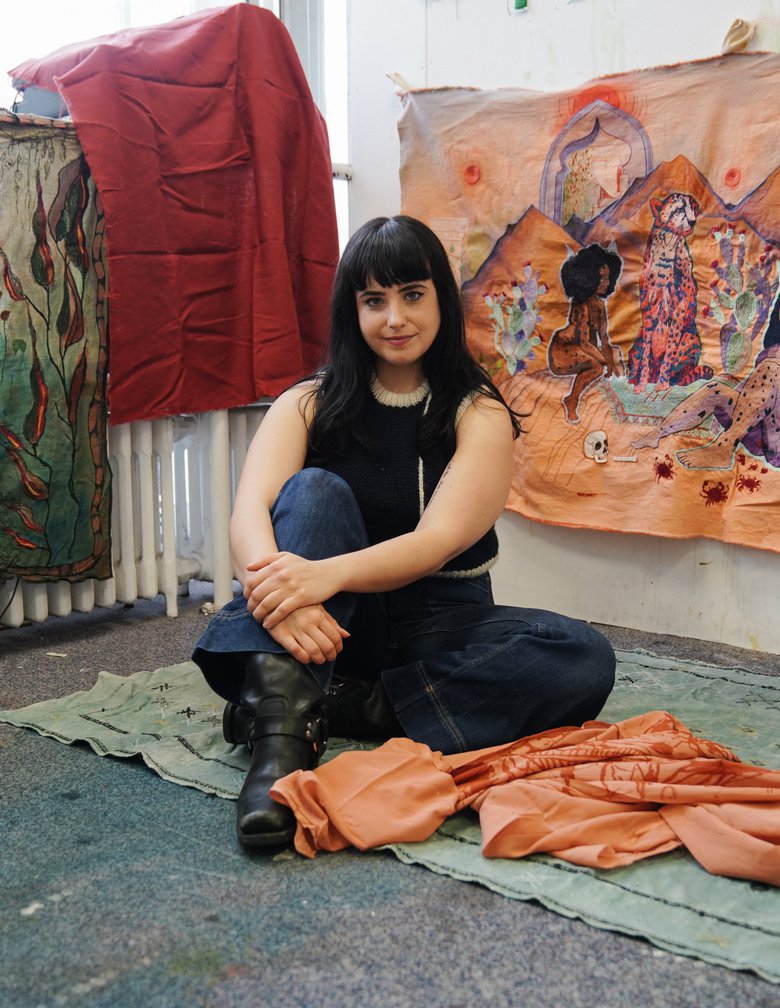article In conversation with
Zeena Wright Al Tai
In conversation with
Zeena Wright Al Tai
Zeena Wright Al Tai

In conversation with Zeena Wright Al Tai,
whose work is heavily influenced by Celtic
Folklore and stories that reflect cultural values
of bygone eras.
whose work is heavily influenced by Celtic
Folklore and stories that reflect cultural values
of bygone eras.
In conversation with Zeena Wright Al Tai,
whose work is heavily influenced by Celtic
Folklore and stories that reflect cultural values
of bygone eras.
Zeena Wright Al Tai is a draw-er and installation artist obsessed with textiles and botanicals, currently living and working in Glasgow.
Inspired by female agency and power in Celtic (and general) folklore, she constructs sublime worlds in which femme and queer figures luxuriate in nature, often using erotic wordplay and florid imagery. These surreal alternate worlds serve as escapism from a sometimes bleak and marginalised reality.
We discovered the fantastical world of Zeena through her submission to last year's Queer Frontiers, where she exhibited the work 'Desert Herland'.
Inspired by female agency and power in Celtic (and general) folklore, she constructs sublime worlds in which femme and queer figures luxuriate in nature, often using erotic wordplay and florid imagery. These surreal alternate worlds serve as escapism from a sometimes bleak and marginalised reality.
We discovered the fantastical world of Zeena through her submission to last year's Queer Frontiers, where she exhibited the work 'Desert Herland'.

Artiq When was the moment you realised you were going to be an artist?
Zeena I used to draw on my family home’s walls and continued to draw everywhere. I fell into it, and also pursued it, in a way.
Artiq Your practice is inspired by Celtic folklore, female agency and a love of botanicals. How do these elements influence each other in your work?
Zeena Here are truths imbued into Folklore and stories which ultimately reflect the values of tribes/cultures of bygone eras. Historically, story time has been a moment of respite -a mélange of cautionary tales meant to terrify children into obedience and lighten everyday life's repetitive labour.
The oral storytelling tradition provides comfort in its promises that dismal situations will change and good will prevail. 'Enter the Lady Garden!' became a method of mythopoetic 1 catharsis by depicting womxn luxuriating in otherworldly environments, devoid of climate catastrophe, assault, marginalisation, and sinister realities of the everyday.
Much like Afro-Futurism, this world-making is both a coping mechanism and a reimagining of what could be, woven with supernatural elements seen in Folkman.
Zeena I used to draw on my family home’s walls and continued to draw everywhere. I fell into it, and also pursued it, in a way.
Artiq Your practice is inspired by Celtic folklore, female agency and a love of botanicals. How do these elements influence each other in your work?
Zeena Here are truths imbued into Folklore and stories which ultimately reflect the values of tribes/cultures of bygone eras. Historically, story time has been a moment of respite -a mélange of cautionary tales meant to terrify children into obedience and lighten everyday life's repetitive labour.
The oral storytelling tradition provides comfort in its promises that dismal situations will change and good will prevail. 'Enter the Lady Garden!' became a method of mythopoetic 1 catharsis by depicting womxn luxuriating in otherworldly environments, devoid of climate catastrophe, assault, marginalisation, and sinister realities of the everyday.
Much like Afro-Futurism, this world-making is both a coping mechanism and a reimagining of what could be, woven with supernatural elements seen in Folkman.

Artiq You've previously told us you're obsessed with textiles. How did this obsession start?
Zeena There is something tactile and meditative about repetitive stitching, cutting, and poking. These movements relate to how I see my practice; a form of sculpting with fibres and textiles, whose movements reference the repetitive labour of centuries past made less gruelling by the telling of folklore and myths.
The antiquated aesthetic hierarchy that concedes certain forms of art over others based on gender associations has historically devalued 'women's work' precisely because it was associated with the domiciliary and the 'feminine'.
Zeena There is something tactile and meditative about repetitive stitching, cutting, and poking. These movements relate to how I see my practice; a form of sculpting with fibres and textiles, whose movements reference the repetitive labour of centuries past made less gruelling by the telling of folklore and myths.
The antiquated aesthetic hierarchy that concedes certain forms of art over others based on gender associations has historically devalued 'women's work' precisely because it was associated with the domiciliary and the 'feminine'.

Artiq sing erotic wordplay and florid imagery, you're often constructing sublime worlds in which femme and queer figures luxuriate in nature. An example of this is Desert Herland which was exhibited in last year's Queer Frontiers'. What do you want the audience to take away from your work?
Zeena The language of printmaking and textiles allows for the tactile meditation in storytelling. The artwork renders spaces of sanctuary, and the repetitive movement of stitching and carving allows for a meditative, reparative state of mind.
As mentioned in section two, the objective of Enter the Lady Garden! is not to form an ideal utopia but rather to beckon missing womxn into their potential worlds; thus, 'Enter the Lady Garden!' is a method of mythopoetic catharsis.
The depiction of womxn luxuriating in otherworldly environments, devoid of climate catastrophe, assault, and marginalisation offers transcendence and redemption.
I cultivate these safe havens in line with Virginia Woolf's theories of possessing a space of one's own. In my practice, the collaborators (subjects) become political driving force the work, which make the viewer question the way they regard womxn. I seek to characterize the narratives around the women, and when delving into themes of revenge, I focus on the femmex perspective, not that of the ravaged.
Anatomy is visceral, personal, mortal, and delicate; it thus invites the viewer to project their own humanity onto the figure, especially when exposing the internal organs and biology of the figure.
Likewise, cutting and stitching reference surgical methods, echoing the anatomic themes which run deep within my work. My practice successfully cultivates space of respite and continues to grow up on the aforementioned thematic concepts as an ever-growing tome that seeks new perspectives and evidence.
Zeena The language of printmaking and textiles allows for the tactile meditation in storytelling. The artwork renders spaces of sanctuary, and the repetitive movement of stitching and carving allows for a meditative, reparative state of mind.
As mentioned in section two, the objective of Enter the Lady Garden! is not to form an ideal utopia but rather to beckon missing womxn into their potential worlds; thus, 'Enter the Lady Garden!' is a method of mythopoetic catharsis.
The depiction of womxn luxuriating in otherworldly environments, devoid of climate catastrophe, assault, and marginalisation offers transcendence and redemption.
I cultivate these safe havens in line with Virginia Woolf's theories of possessing a space of one's own. In my practice, the collaborators (subjects) become political driving force the work, which make the viewer question the way they regard womxn. I seek to characterize the narratives around the women, and when delving into themes of revenge, I focus on the femmex perspective, not that of the ravaged.
Anatomy is visceral, personal, mortal, and delicate; it thus invites the viewer to project their own humanity onto the figure, especially when exposing the internal organs and biology of the figure.
Likewise, cutting and stitching reference surgical methods, echoing the anatomic themes which run deep within my work. My practice successfully cultivates space of respite and continues to grow up on the aforementioned thematic concepts as an ever-growing tome that seeks new perspectives and evidence.

Artiq What are you looking forward to in 2023?
Zeena I’ve been working on my master’s degree at Glasgow School of Art which
has thus far been super enjoyable! I have an interim show coming up in March and have applied to loads of things-will keep you all posted on what comes up! I’m hoping to do a residency this summer so fingers crossed!
Artiq Can you recommend an artist you think everyone should know about?
Zeena EVERYONE should know about my mentor, Dr. Zoe Mendelson!
"Zoë Mendelson's specific research interests as an artist are focused on disorder-in psychological terms-as a culturally produced phenomenon, in parallel to its clinical and spatial counterparts. She is interested in how culture coopts psychological and medical motifs and spectaculars them, leading to complex and widespread misreadings. This has led her to produce artworks in direct response to imagery produced or used within medicine self-particularly in diagnostics"
To learn more about Zeena Wright Al Tai's practice, visit her Website or Instagram.
Zeena I’ve been working on my master’s degree at Glasgow School of Art which
has thus far been super enjoyable! I have an interim show coming up in March and have applied to loads of things-will keep you all posted on what comes up! I’m hoping to do a residency this summer so fingers crossed!
Artiq Can you recommend an artist you think everyone should know about?
Zeena EVERYONE should know about my mentor, Dr. Zoe Mendelson!
"Zoë Mendelson's specific research interests as an artist are focused on disorder-in psychological terms-as a culturally produced phenomenon, in parallel to its clinical and spatial counterparts. She is interested in how culture coopts psychological and medical motifs and spectaculars them, leading to complex and widespread misreadings. This has led her to produce artworks in direct response to imagery produced or used within medicine self-particularly in diagnostics"
To learn more about Zeena Wright Al Tai's practice, visit her Website or Instagram.